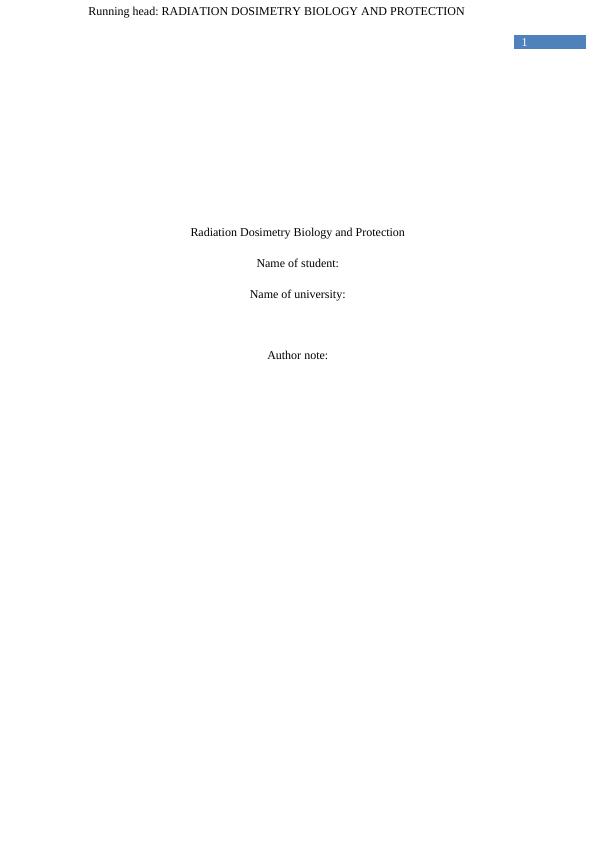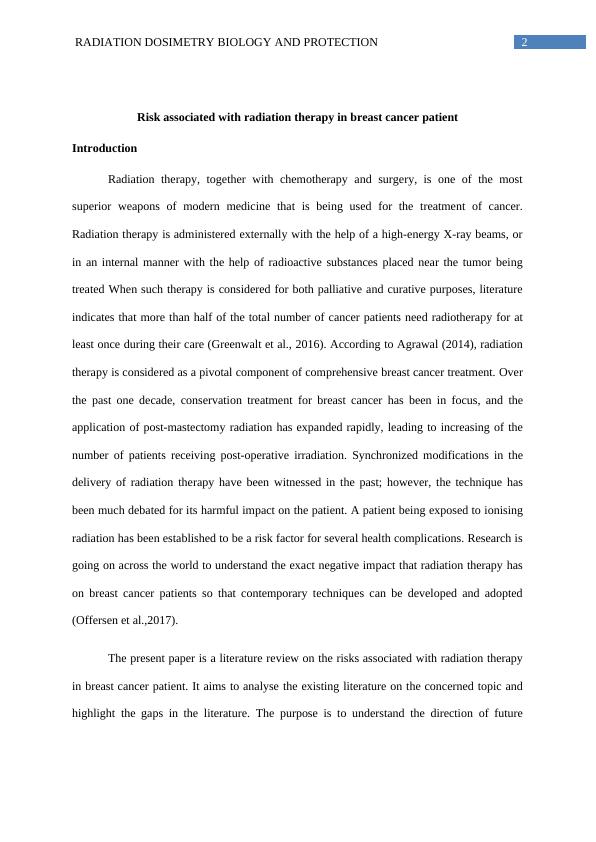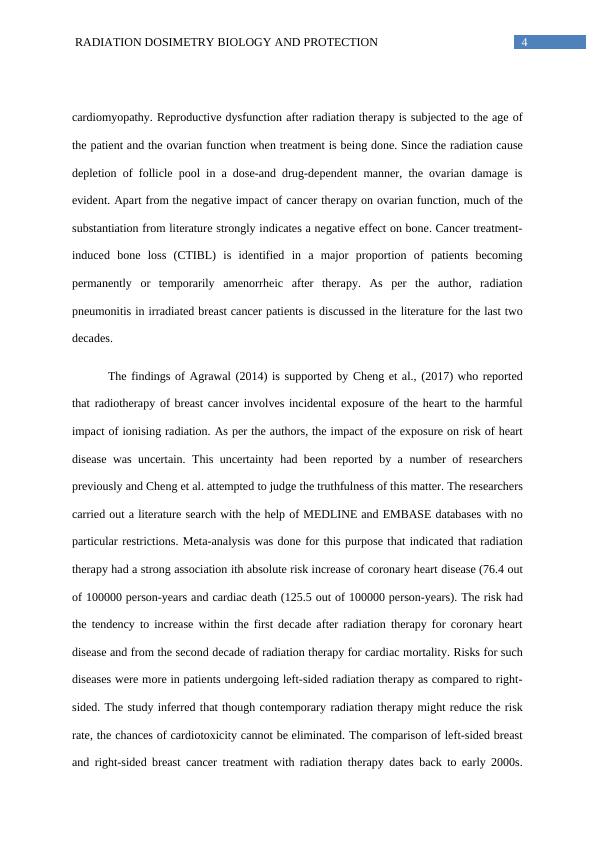Radiation Dosimetry Biology and Protection Assignment
Added on 2020-04-07
15 Pages4599 Words48 Views
1Running head: RADIATION DOSIMETRY BIOLOGY AND PROTECTIONRadiation Dosimetry Biology and ProtectionName of student:Name of university:Author note:

2 RADIATION DOSIMETRY BIOLOGY AND PROTECTIONRisk associated with radiation therapy in breast cancer patientIntroductionRadiation therapy, together with chemotherapy and surgery, is one of the mostsuperior weapons of modern medicine that is being used for the treatment of cancer.Radiation therapy is administered externally with the help of a high-energy X-ray beams, orin an internal manner with the help of radioactive substances placed near the tumor beingtreated When such therapy is considered for both palliative and curative purposes, literatureindicates that more than half of the total number of cancer patients need radiotherapy for atleast once during their care (Greenwalt et al., 2016). According to Agrawal (2014), radiationtherapy is considered as a pivotal component of comprehensive breast cancer treatment. Overthe past one decade, conservation treatment for breast cancer has been in focus, and theapplication of post-mastectomy radiation has expanded rapidly, leading to increasing of thenumber of patients receiving post-operative irradiation. Synchronized modifications in thedelivery of radiation therapy have been witnessed in the past; however, the technique hasbeen much debated for its harmful impact on the patient. A patient being exposed to ionisingradiation has been established to be a risk factor for several health complications. Research isgoing on across the world to understand the exact negative impact that radiation therapy hason breast cancer patients so that contemporary techniques can be developed and adopted(Offersen et al.,2017). The present paper is a literature review on the risks associated with radiation therapyin breast cancer patient. It aims to analyse the existing literature on the concerned topic andhighlight the gaps in the literature. The purpose is to understand the direction of future

3 RADIATION DOSIMETRY BIOLOGY AND PROTECTIONresearch that would bring a drastic change in the delivery of radiation therapy for breastcancer patients.Literature reviewAdvancements in the screening and treatment of breast cancer have emerged from theresearch domain putting in efforts to enable best possible patient outcomes. The survival rateof breast cancer patients has increased solely due to such advancements, one of which isradiation therapy. For particular at-risk groups of women undergoing mastectomy for tumourremoval, postmastectomy radiation therapy (PMRT) is known to reduce the risk of recurrenceat the locoregion and improve chances of survival. Evidence-based studies and population-based studies point out to the fact that the use of radiation therapy is increasing with eachpassing year (Jethwa et al., 2017). However, studies on the impact of the radiation on thepatient body post-therapy have thrown light on a number of risk factors associated withradiation exposure and are to be discussed in here. Agrawal (2014) highlighted the concerns raised about the risk of chronic and acuteside effects of radiation therapy in breast cancer survivors. As per the author, the mostnoteworthy impact of radiation therapy includes reproductive dysfunction, cardiac toxicity,skin changes, arm lymph oedema, pneumonitis (RP) and neuropathy. These are some of thecomplications arising from adjuvant treatment. Cardiovascular toxicity that is chemotherapy-induced include cardiomyopathy that might or might not be accompanied by endothelialdysfunction, overt congestive heart failure (CHF) and arrhythmias. RT-inducedcardiovascular toxicity includes valvular disease, coronary artery disease (CAD), arrhythmiasand conduction disturbances, chronic pericardial disease, carotid artery stenosis and

4 RADIATION DOSIMETRY BIOLOGY AND PROTECTIONcardiomyopathy. Reproductive dysfunction after radiation therapy is subjected to the age ofthe patient and the ovarian function when treatment is being done. Since the radiation causedepletion of follicle pool in a dose-and drug-dependent manner, the ovarian damage isevident. Apart from the negative impact of cancer therapy on ovarian function, much of thesubstantiation from literature strongly indicates a negative effect on bone. Cancer treatment-induced bone loss (CTIBL) is identified in a major proportion of patients becomingpermanently or temporarily amenorrheic after therapy. As per the author, radiationpneumonitis in irradiated breast cancer patients is discussed in the literature for the last twodecades. The findings of Agrawal (2014) is supported by Cheng et al., (2017) who reportedthat radiotherapy of breast cancer involves incidental exposure of the heart to the harmfulimpact of ionising radiation. As per the authors, the impact of the exposure on risk of heartdisease was uncertain. This uncertainty had been reported by a number of researcherspreviously and Cheng et al. attempted to judge the truthfulness of this matter. The researcherscarried out a literature search with the help of MEDLINE and EMBASE databases with noparticular restrictions. Meta-analysis was done for this purpose that indicated that radiationtherapy had a strong association ith absolute risk increase of coronary heart disease (76.4 outof 100000 person-years and cardiac death (125.5 out of 100000 person-years). The risk hadthe tendency to increase within the first decade after radiation therapy for coronary heartdisease and from the second decade of radiation therapy for cardiac mortality. Risks for suchdiseases were more in patients undergoing left-sided radiation therapy as compared to right-sided. The study inferred that though contemporary radiation therapy might reduce the riskrate, the chances of cardiotoxicity cannot be eliminated. The comparison of left-sided breastand right-sided breast cancer treatment with radiation therapy dates back to early 2000s.

End of preview
Want to access all the pages? Upload your documents or become a member.
Related Documents
Advantage of mastectomy: a novel approach to improve outcomes in early breast cancer patientslg...
|20
|4828
|85
Molecular Cloning of BIG3 Gene in Breast Cancerlg...
|17
|5695
|72
Molecular Cloning of BIG3 Gene Associated with Secondary Breast Cancer in the Brainlg...
|7
|1968
|1
Male Breast Cancerlg...
|4
|797
|193
Improving Patient Journey and Provider Experience in Breast Cancer Carelg...
|24
|7115
|494
Burden of Breast Cancer as a Non-Communicable Disease: Global and National Trends, Modifiable Risk Factors, and Key Policies in Australia and Internationallylg...
|13
|1304
|365
